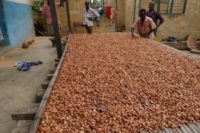Securing Play Value
Novelty/interactive candy isn’t just playing around; it’s aiming for a more stable shelf spot.
The thinking is, if you
build a playground, the kids will come. So why haven’t most mass
retailers given novelty/interactive candy a permanent
“playground” in the candy aisles?
The category continued to lose some share in 2004 in
the food, drug and mass retail outlets tracked by Information Resources
Inc. According to IRI, dollar sales dropped nearly 8 percent in the
non-chocolate sub-segment vs. 2003; chocolate novelty sales were down
nearly 26 percent. But because the play value makes more sense in
combination with the durability of non-chocolate candy, and because the
typical novelty-candy kid consumer prefers non-chocolate candy to
chocolate, players needn’t be as concerned about the slip in
chocolate novelty sales. It was never the driver of the category. But
non-chocolate novelty candy is not holding its own like it once was, and
that is the sub-segment retailers have the ability to bring back.
Novelty candy as we know it now is about 10 years old,
and yet most mass retailers are still using it as an “in and
out” candy category. While kids will gravitate to it when it’s
available, they can never be sure when or where they’ll find it,
especially when they tag along with mom to the grocery store. Some mass
retailers do have a novelty candy space, but it’s severely limited to
a few items that are typically not rotated or merchandised properly,
according to industry experts. On the other hand, smaller retailers, such
as movie rental chains and convenience stores, have been credited with
creating a decent novelty candy space. It’s often a small space, but
at least kids know they can find it there.
Imperatives
Uniqueness and originality still drive this category,
which is probably why so many retailers have been reluctant to give the
category a permanent home. Kids are product-savvy and their wants change
almost daily. But novelty candy manufacturers are in tune to this.
Retailers also need to be in tune with what’s hot and what has
passed—and not be afraid to make some mistakes along the way.
Retailers have not even come close to maxing out this
category, mostly because candy buyers are afraid to make a true commitment
to it. They’ve been accused of being too timid with
novelty/interactive candy. Many say that the only way to really make this
candy category work is to get the toy buyer involved and to treat the
section more like that of impulse toys where new items are launched fairly
regularly, but the space is fixed for that purpose.
While novelty candy can include licensed candy, it is
not synonymous with it. Too often, retailers assume too short of a shelf
life for novelty.
Consumers
This category definitely falls to “the younger
set.” Children are the right age for novelty candy starting at about
four or five, and they stay interested probably until 11 or 12. Their youth
only makes them more savvy to trends, and make no mistake about it, they
have significant buying power and influence. Studies have been conducted on
their ability to steer parents to certain fast food chains for the sake of
a collectible toy. Retailers who offer and promote that same toy value in
novelty candy that is always available at their stores have a good chance
of becoming a child’s favorite stop.
Adjacencies
Positioning novelty candy in other child-frequented
areas of the store, such as cereal, and even gift-wrap, where parents get
the idea that novelty candy can be a package decoration, has had a lot of
success. Of course, offering it in and near toys should be a no-brainer.
And while a permanent department spot is recommended in either toys or
candy, retailers can use the other location, as well as cereal aisles, gift
wrap, etc. to utilize the “in and out” promotions. This is
where power wings, clip strips and floor displays can come in very handy.
Seasonality
It certainly would behoove retailers to start thinking
of novelty candy as an everyday toy/candy business. However, that
doesn’t mean there isn’t great opportunity in seasonal
outposts. Holidays where parents like to find “little” toys,
such as Valentine’s Day, Halloween, and especially Easter—are
perfect novelty candy seasons. Manufacturers also mention that stocking
stuffer end caps featuring novelty candy did very well in last year’s
fourth quarter.
Outlook
The growth in the category is going to come from
retailers that permanently get into it and then learn how to manage it
properly. The biggest realization once they build it is that it will get
shopped a lot, and therefore, will require more tending. In a sense, it
might become like bulk candy in that it will need constant rotation and
attention. While most retailers are equipped with store personnel in the
toy department, it’s rare to see anyone in candy, with the possible
exception of bulk. If a permanent novelty section is to succeed, that will
have to change. But with a well conceived novelty/interactive candy
section, retailers in all classes of trade have the potential to mirror on
a smaller scale the successes of more upscale candy stores, such as FAO
Schweetz and Dylan’s Candy Bar in New York City—candy havens
that kids halfway across the country have heard about and dream of
visiting. n
Merchandising Musts
Go low.
Novelty candy needs to be positioned on shelves that are not too high. If a retailer can position the candy on lower shelves, it makes it more convenient for the savvy young shoppers to comparison shop without too much strain or stress on the shelf. Just remember: impulse buys are purposefully positioned at eye level for adults. It only makes sense to put kid impulse buys at their eye level. Most manufacturers agree that a good kid eye level mark is typically half that of adults.
Novelty candy needs to be positioned on shelves that are not too high. If a retailer can position the candy on lower shelves, it makes it more convenient for the savvy young shoppers to comparison shop without too much strain or stress on the shelf. Just remember: impulse buys are purposefully positioned at eye level for adults. It only makes sense to put kid impulse buys at their eye level. Most manufacturers agree that a good kid eye level mark is typically half that of adults.
Start thinking destination.
Endcaps and outposts are great impulse vehicles for novelty/interactive candy, but it’s really time mass retailers start building a significant home for the category. Just like toys have always had a place at these retailers, so too, will little toys and candy.
Endcaps and outposts are great impulse vehicles for novelty/interactive candy, but it’s really time mass retailers start building a significant home for the category. Just like toys have always had a place at these retailers, so too, will little toys and candy.
In fact, retailers will most likely get more turns
from a well-managed novelty candy set than an over-extended, higher-priced
toy set. Having 10 feet of space devoted to toys and zero space for
interactive/novelty candy is illogical these days. In a down economy,
retailers have a better chance of selling a $3.99 Spin Pop over a $19.99
Mr. Potato Head. And compared to just regular candy bars, the margins in
novelty are far superior.
Candy buyers and toy buyers should work together to
create the perfect novelty plan-o-gram. Any retailer that initiates this
will be ahead of its time in combating one of the biggest industry
complaints: buyer segregation. So building a novelty candy destination can
actually be a bigger move for retailers than one might think.


